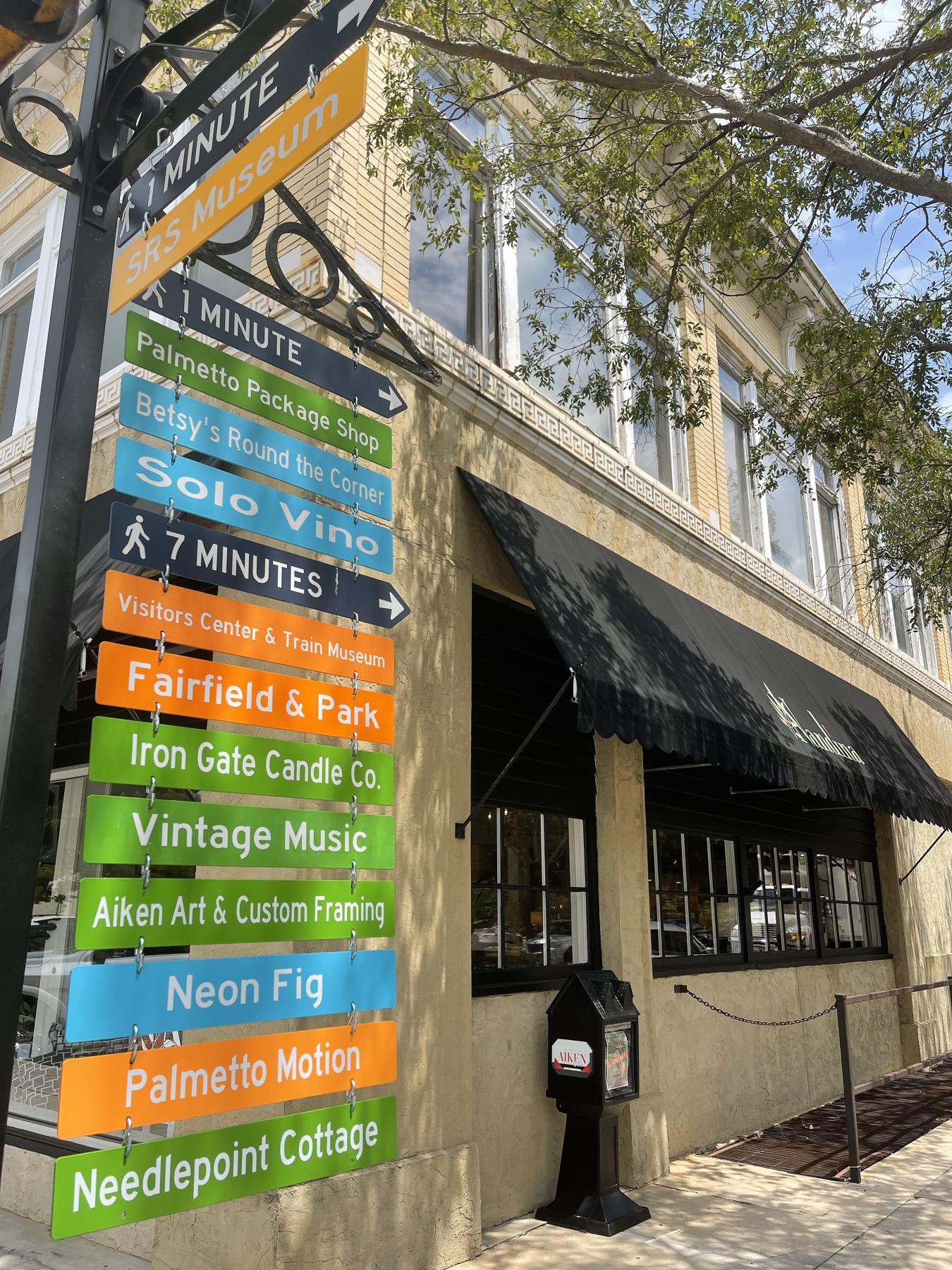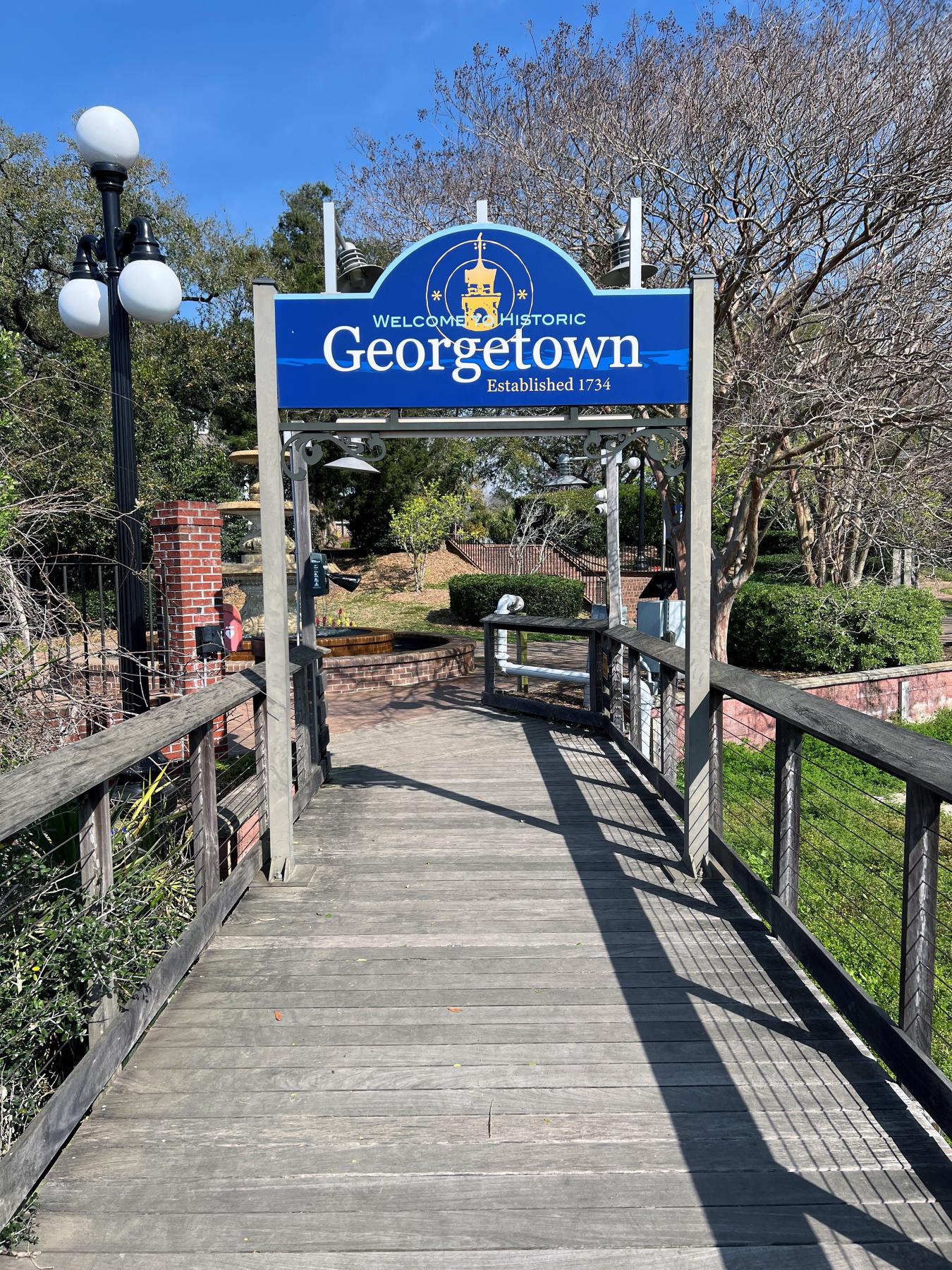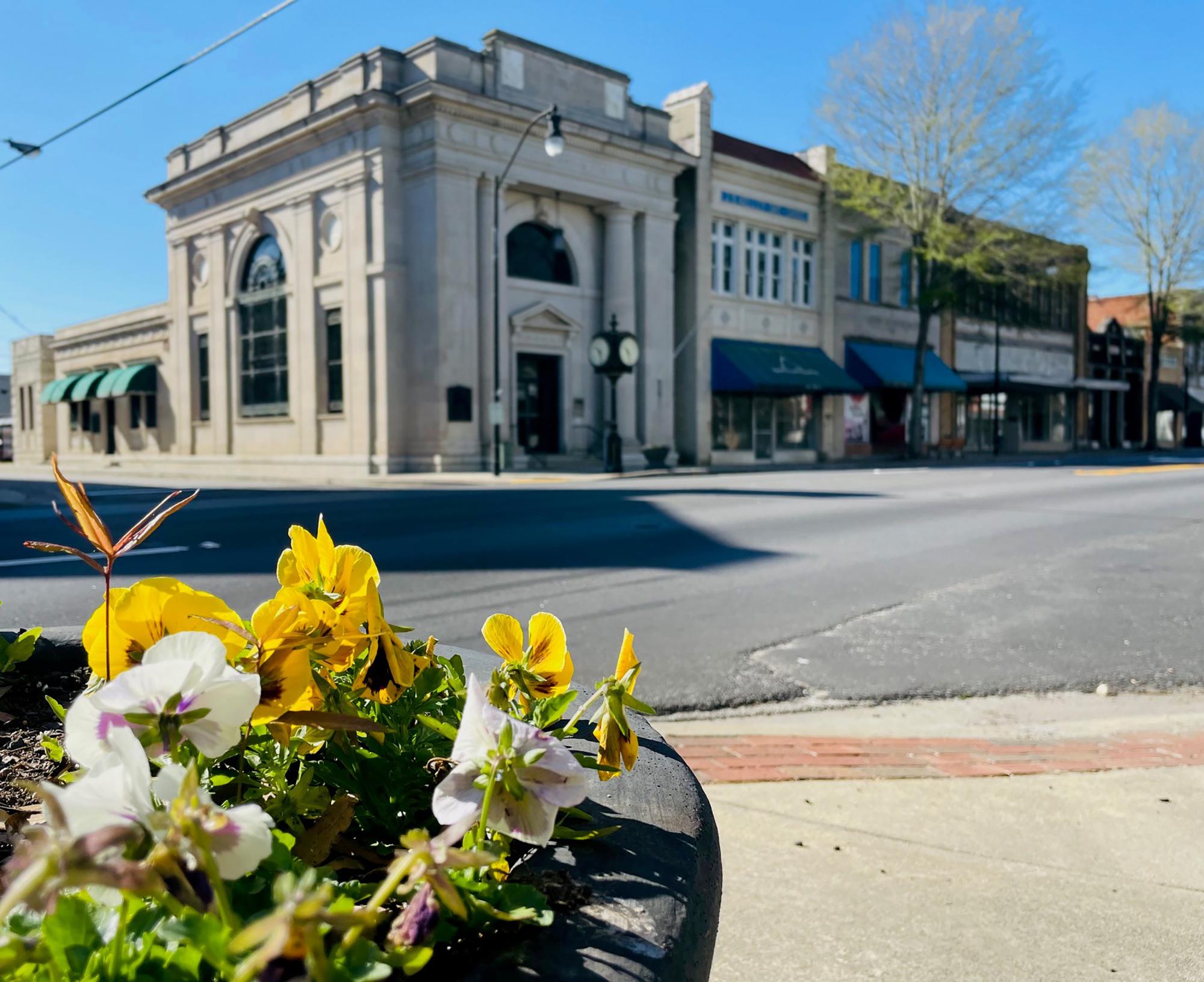Across the state, cities and towns have guided significant transformation of their downtown districts. Among these success stories are Aiken, Georgetown and Bishopville, each with distinctive leadership styles and strategies.

Signage, like these signs at Laurens Street and Park Avenue, point the way to destinations
throughout Aiken's downtown. Photo: City of Aiken.
With a population exceeding 32,000 residents, Aiken curates an award-winning downtown with more than 170 tree-line parkways and an abundance of public art installations. Renowned for its equestrian facilities and one of the nation’s largest urban forests, Aiken attracts visitors locally and even internationally. The downtown’s vibrant mix of boutique shops, art galleries, and gourmet restaurants also appeals to arts and culture enthusiasts.
At the forefront of the downtown revitalization efforts is the Aiken Downtown Development Association, dedicated to preserving the city's historic charm while guiding economic growth and vibrancy. Through strategic planning and community engagement, ADDA plays a pivotal role in revitalizing Aiken's historic downtown district, focusing on small business support and citywide partnerships.
“ADDA is blessed to have two paid staff, but we could not do what we do without our volunteers,” ADDA Executive Director EmmaLee Sams said. “Our 20-member board plays a huge role in regularly connecting with our community members. Our board members represent the banking and [real estate] sectors as well as business owners; we also have representation from the city, USC Aiken, and the Chamber of Commerce. We talk weekly with our executive board and we meet with the whole board once a month, focusing on prioritized initiatives. Our volunteers genuinely want to help in any way; they want to know what we’re doing and how they can participate in moving initiatives forward.”
In 2023, ADDA recorded a total of 1,470 volunteer hours dedicated to completing numerous downtown projects.
By providing support and resources to small businesses, including marketing assistance and promotional events, ADDA catalyzes positive change, ensuring that downtown thrives as a hub of commerce, culture and community.
Sams described relationship building as a key strength for ADDA.
“We host quarterly merchant meetings to get to know the business owners and community members and to share ways to support one another,” she said. “These meetings also reveal local business needs that we can respond to with developing and providing specific resources and connections.”
The significance of Aiken’s historic downtown resonates throughout the community, among businesses, building owners, city leaders and civic organizations.
“As a community, we share a common goal — to help ensure that Aiken’s downtown is prosperous and welcoming to all,” Sams said.
Georgetown

Georgetown's Harborwalk has a connection to the Joseph H. Rainey Park. Photo: City of Georgetown.
The City of Georgetown, situated on the coast with a harborwalk and plenty of historic architecture, has experienced a remarkable downtown transformation. With a population of over 8,400 residents, its collaborative efforts with community organizations, private developers and residents have inspired investments.
This past year, the city achieved significant milestones, including its designation as the state's 11th Cultural District through the SC Arts Commission, the revival of the farmers market, the opening of three new restaurants as well as seven new shops and boutiques, and the debut of a 56-room boutique hotel. A historic bank building is being renovated into a brewery/distillery, a $4 million project that will reactivate over a quarter of a city block.
The City of Georgetown’s Main Street Director Al Joseph stressed the importance of having dedicated staff who are focused on the downtown district.
“Having someone in this position that is able to promote Georgetown, spread Georgetown’s story, work with our marketing team and with the Georgetown Business Association – that's why we're seeing such a resurgence,” he said.
Joseph noted that Georgetown’s “biggest focus in the past 20 months has been promotion of the city – internally and externally. During our annual business owners meeting we share what’s happening at a city level and then it’s open discussion by the business owners. These moments of sharing are invaluable. This position [the City of Georgetown’s Main Street Director] is the point of contact for building owners to help identify new tenants and to welcome new businesses.”
A key aspect of Georgetown's downtown revival has been its waterfront development. The city's harbor, once a hub of maritime activity, has been transformed into a vibrant waterfront destination.
After a seven-year effort, dredging of Georgetown’s channel to a depth of 12 feet is “going to open us up to an entirely different demographic for tourism by providing access to larger pleasure boats and yachts,” Joseph said. “Georgetown is the only place on the Eastern Seaboard that has a confluence of five rivers, a bay and the ocean only 10 miles away.”
Bishopville

Bishopville's leaders are developing a master plan for the development of its historic downtown.
Widely known for Pearl Fryar’s Topiary Garden, Bishopville is home to more than 3,000 residents. The municipal initiatives for Bishopville’s downtown are led by councilmembers who serve on committees dedicated to managing special projects for the city. The committee that oversees Bishopville’s Main Street program, the three-member Commercial Affairs Committee, includes Gloria Lewis.
“With councilmembers serving as committee chairs and committee members, we get to be closer to the work. Because of this, we don't think of it as a job but view as giving back to our communities, especially since many of us are also business owners and active community members outside of the council,” Lewis said.
Understanding the value of coordinating and focusing economic development efforts, the City of Bishopville is in the final stages of approving its downtown master plan, to provide a clear long-term vision.
“Having a strategic plan helps determine how to use resources, land, and funding appropriately, helping us to stay on track with planning for the city,” Lewis said. “Even when a transfer of mayor and council occurs, the strategic plan serves as a north star for both current and incoming leaders. It helps us remain on task to complete ongoing projects, keeps the needs of our city and residents at the forefront of what we do by prioritizing high-priority projects before moving forward to other projects, and provides us with checks and balances to keep us from going astray.”
One significant revitalization effort includes the renovation of the historic railroad depot. The goal of this $1.4 million project is to remove several dilapidated buildings from the railroad line located at the center of the city. The city will remodel the historic brick depot building and install a parking lot, sidewalks, lighting and flowers to encourage more downtown pedestrian traffic. Once completed, this space will be a home for community activities, a potential farmer's market, recreational green space for outdoor activities, live music, festivals, and a private event venue.
Community engagement has also played a vital role in Bishopville's downtown revival. Through workshops and outreach, residents have had a voice in shaping their community’s future. This collaborative approach has fostered a sense of ownership and pride among Bishopville's residents, driving further investment and participation in the revitalization efforts.
Connecting and collaborating
At the heart of South Carolina’s thriving communities are the residents, small business owners, and city leaders who collectively shape and guide their downtown revitalization efforts. Aiken, Georgetown and Bishopville exemplify successful approaches to historic downtown district revitalization, showcasing the power of collaboration and community engagement.
Main Street South Carolina is a technical assistance program of the Municipal Association of SC. It offers several community membership levels ranging in cost and requirements.
